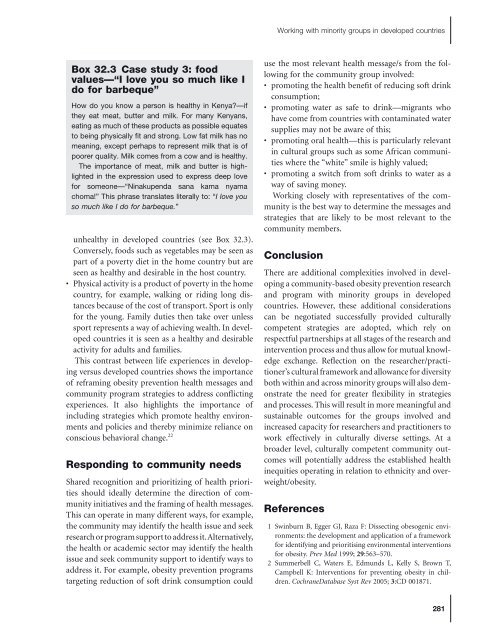Preventing Childhood Obesity - Evidence Policy and Practice.pdf
Preventing Childhood Obesity - Evidence Policy and Practice.pdf
Preventing Childhood Obesity - Evidence Policy and Practice.pdf
Create successful ePaper yourself
Turn your PDF publications into a flip-book with our unique Google optimized e-Paper software.
Working with minority groups in developed countries<br />
Box 32.3 Case study 3: food<br />
values — “ I love you so much like I<br />
do for barbeque ”<br />
How do you know a person is healthy in Kenya? — if<br />
they eat meat, butter <strong>and</strong> milk. For many Kenyans,<br />
eating as much of these products as possible equates<br />
to being physically fit <strong>and</strong> strong. Low fat milk has no<br />
meaning, except perhaps to represent milk that is of<br />
poorer quality. Milk comes from a cow <strong>and</strong> is healthy.<br />
The importance of meat, milk <strong>and</strong> butter is highlighted<br />
in the expression used to express deep love<br />
for someone — “ Ninakupenda sana kama nyama<br />
choma! ” This phrase translates literally to: “ I love you<br />
so much like I do for barbeque. ”<br />
unhealthy in developed countries (see Box 32.3 ).<br />
Conversely, foods such as vegetables may be seen as<br />
part of a poverty diet in the home country but are<br />
seen as healthy <strong>and</strong> desirable in the host country.<br />
• Physical activity is a product of poverty in the home<br />
country, for example, walking or riding long distances<br />
because of the cost of transport. Sport is only<br />
for the young. Family duties then take over unless<br />
sport represents a way of achieving wealth. In developed<br />
countries it is seen as a healthy <strong>and</strong> desirable<br />
activity for adults <strong>and</strong> families.<br />
This contrast between life experiences in developing<br />
versus developed countries shows the importance<br />
of reframing obesity prevention health messages <strong>and</strong><br />
community program strategies to address conflicting<br />
experiences. It also highlights the importance of<br />
including strategies which promote healthy environments<br />
<strong>and</strong> policies <strong>and</strong> thereby minimize reliance on<br />
conscious behavioral change. 22<br />
Responding to c ommunity n eeds<br />
Shared recognition <strong>and</strong> prioritizing of health priorities<br />
should ideally determine the direction of community<br />
initiatives <strong>and</strong> the framing of health messages.<br />
This can operate in many different ways, for example,<br />
the community may identify the health issue <strong>and</strong> seek<br />
research or program support to address it. Alternatively,<br />
the health or academic sector may identify the health<br />
issue <strong>and</strong> seek community support to identify ways to<br />
address it. For example, obesity prevention programs<br />
targeting reduction of soft drink consumption could<br />
use the most relevant health message/s from the following<br />
for the community group involved:<br />
• promoting the health benefit of reducing soft drink<br />
consumption;<br />
• promoting water as safe to drink —migrants who<br />
have come from countries with contaminated water<br />
supplies may not be aware of this;<br />
• promoting oral health —this is particularly relevant<br />
in cultural groups such as some African communities<br />
where the “ white ” smile is highly valued;<br />
• promoting a switch from soft drinks to water as a<br />
way of saving money.<br />
Working closely with representatives of the community<br />
is the best way to determine the messages <strong>and</strong><br />
strategies that are likely to be most relevant to the<br />
community members.<br />
Conclusion<br />
There are additional complexities involved in developing<br />
a community - based obesity prevention research<br />
<strong>and</strong> program with minority groups in developed<br />
countries. However, these additional considerations<br />
can be negotiated successfully provided culturally<br />
competent strategies are adopted, which rely on<br />
respectful partnerships at all stages of the research <strong>and</strong><br />
intervention process <strong>and</strong> thus allow for mutual knowledge<br />
exchange. Reflection on the researcher/practitioner<br />
’ s cultural framework <strong>and</strong> allowance for diversity<br />
both within <strong>and</strong> across minority groups will also demonstrate<br />
the need for greater flexibility in strategies<br />
<strong>and</strong> processes. This will result in more meaningful <strong>and</strong><br />
sustainable outcomes for the groups involved <strong>and</strong><br />
increased capacity for researchers <strong>and</strong> practitioners to<br />
work effectively in culturally diverse settings. At a<br />
broader level, culturally competent community outcomes<br />
will potentially address the established health<br />
inequities operating in relation to ethnicity <strong>and</strong> overweight/obesity.<br />
References<br />
1 Swinburn B , Egger GJ , Raza F : Dissecting obesogenic environments:<br />
the development <strong>and</strong> application of a framework<br />
for identifying <strong>and</strong> prioritising environmental interventions<br />
for obesity . Prev Med 1999 ; 29 : 563 – 570 .<br />
2 Summerbell C , Waters E , Edmunds L , Kelly S , Brown T ,<br />
Campbell K : Interventions for preventing obesity in children<br />
. CochraneDatabase Syst Rev 2005 ; 3 : CD 001871 .<br />
281

















